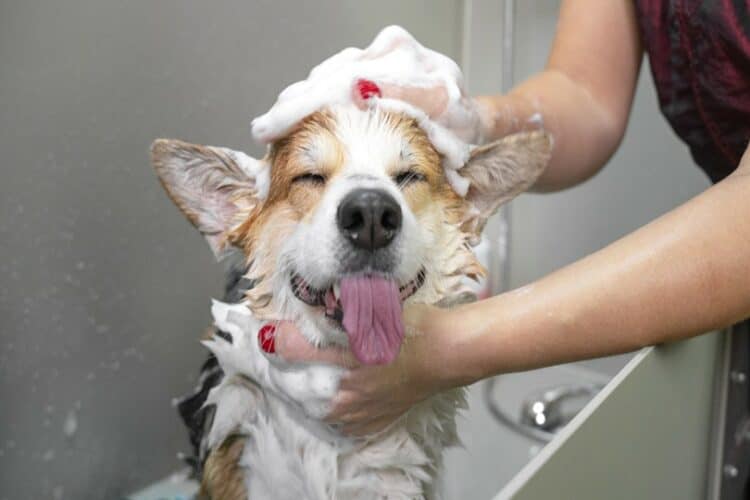Dry, flaky, itchy skin does more than irritate your dog. It could lead to an infection or be associated with another serious medical condition. Part of putting a stop to the itching is identifying the cause of the dry skin. From there, you can work through potential solutions that will (most likely) include consulting a veterinarian. There are ways to treat and prevent dry skin from returning, so your dog can stay happy and healthy.
Symptoms of Dry Skin

Image courtesy of Unsplash
For a dog, flaky skin is usually caused by more than just dry skin. An underlying disease is often to blame, so you might see other symptoms like1:
The scratching and biting that often go along with dry skin can be just as dangerous to the dog as the underlying cause. Open wounds create an avenue for infection and further health problems. Consequently, it’s important to treat dry skin before it becomes a more serious problem.
Causes of Dogs’ Dry Skin
Causes of your dog’s flaky skin can range from simple—like dry winter air—to complex chronic disorders like hypothyroidism. Any of the following (and more!) could be behind a dog’s dry skin.
Allergies
Dogs can suffer from food, environmental, and seasonal allergies, any of which can cause skin problems. Common ingredients in dog food like beef or chicken can trigger allergies for some dogs. Environmental and seasonal allergies are even more frequent and originate within a dog’s surroundings. Triggers include things such as dust mites, grasses, pollen, and mold spores.5 Amid the many potential allergens, flea saliva remains one of the most common. However, as you’ll see in the treatment and prevention sections, there are ways to keep allergy-related dry skin under control.
Parasites
Though they’re not pleasant to think about, parasites are a potential cause of dry, itchy skin. In dogs, the most common are fleas, ticks, the Demodex mite, and canine scabies.6 Lice are another creepy-crawly that could cause canine skin problems. You’ll need a veterinarian to diagnose the type of parasite (except maybe for fleas and ticks) and recommend a treatment.
Hormonal Diseases
Itching and flaking can be an outer symptom of an inner, hormonal problem, with the most common among dogs being Cushing’s disease and hypothyroidism. Cushing’s disease, also known as hyperadrenocorticism, is often seen in middle age to older dogs and certain breeds like Standard Schnauzers and Fox Terriers.7 A hormonal disease requires diagnosis and treatment guided by a veterinarian.
Infection
Many bacterial and fungal infections cause itchy, dry skin. These types of infections include everything from yeast infections to Staphylococcus strains. Some conditions like allergies or Cushing’s disease can make a dog more likely to get a skin infection.
Diet
A dog’s diet influences every aspect of its health, including the skin and coat. Dietary insufficiencies can definitely contribute to dry skin, hair loss, and other visible symptoms of ill health. If diet lies behind the problems, you may need to work with a veterinarian to determine if your dog is getting the right nutrients based on its age and lifestyle or to diagnose a food allergy.
Breed-Specific Skin Problems
Some dog breeds are prone to skin problems due to the inbreeding that’s been used to enhance some features and eliminate others. Hairless breeds like the Xoloitzcuintli and the Peruvian Inca Orchid tend to have skin issues, though you don’t have to worry about shedding. Breeds that grow thick coats, like Newfoundlands and Malamutes, are prone to skin problems if they aren’t groomed regularly. Other breeds like Bulldogs, Shar-Peis, and Doberman Pinschers are prone to allergies, hypothyroidism, and other medical conditions that include dry skin among their symptoms.
Treatment for Dry Skin

Photo courtesy of Unsplash
For most pet owners, treatment of their dog’s dry skin starts with a visit to the veterinarian’s office. That’s the only way to rule out some of the more serious issues that could be at work.
If the veterinarian suspects food allergies, she may recommend an elimination diet. In this case, you would buy dog food with a limited ingredient list or that is made with hydrolyzed proteins to see how the dog reacts to it. It’s a process of eliminating potential allergens and gradually reintroducing them until you find the offending ingredients.8
Seasonal or environmental allergies require a multi-pronged approach of avoiding the allergen to the greatest extent possible and reducing sensitivity to it. For example, effective flea prevention will prevent dry skin caused by an allergy to flea saliva. However, it’s difficult to eliminate a dog’s exposure to pollen. In that case, medications and allergy shots may help.9
Other treatment options may include:
- Dietary changes or supplements10
- Medicated shampoos
- Topical ointments and creams
- Flea and tick treatments
- Use of a humidifier (or dehumidifier)
Preventing Dry Skin
Prevention makes life better for you and your dog. While preventative measures may not stop all dry skin episodes, they can reduce them. Basic prevention includes:
- A complete and balanced diet with high-quality dog food
- Regular flea and tick treatments
- Following veterinarian’s instructions, including the use of medications, supplements, and medicated shampoos
- Keeping the skin clean, but not over-bathing the dog
- Knowing what illnesses the breed is susceptible to
- Using gentle dog-specific shampoos and products
- Regular veterinary checkups
Dogs are the happy-go-lucky members of the household. When they’re healthy, they’re happy. Preventative care and quick treatment should dry skin arise will keep your dog cheerful and ready to take on life.
Featured Image Credit: Masarik, Shutterstock
- Burke A. Dry skin on dogs: Causes, symptoms, and treatment. AKC.org Published May 19, 2016. Accessed April 19, 2021.
- Moriello KA. Pruritus in animals. Merckvetmanual.com Updated January 2020. Accessed April 19.2021.
- Bloom P. Canine scaling disorders. Cliniciansbrief.com Published July 2007. Accessed April 19, 2021.
- Moriello KA. Alopecia in animals. Merckvetmanual.com Updated January 2020. Accessed April 19, 2021.
- Hill PB and DeBoer DJ. The ACVD task force on canine atopic dermatitis(IV): environmental allergies. Veterinary Immunology and Immunopathology. 2001;81(3-4): 169-186. doi: 10.1016/S0165-2427(01)00298-7
- Dryden MW. Mite infestation (mange, acariasis, scabies) in dogs. Merckvetmanual.com Updated June 2018. Accessed April 19, 2021.
- Carotenuto G, Malerba E, Dolfini C, et al. Cushing syndrome-an epidemiological study based on a canine population of 21,281 dogs. Open Veterinary Journal. 2019;9(1): 27-32. doi: 10.4314/ovj.v9i1.5
- Balima NS and Rajasekaran R. Clinical management of food allergy in a dog. Journal of Entomology and Zoology Studies. 2020;8(4): 1586-1588. Accessed April 19, 2021.
- Marro A, Pirles M, Schiaffino L, et al. Successful immunotherapy of canine flea allergy with injected Actinomycetales preparations. Immunotherapy. 2011; 3(8). doi: 10.2217/imt.11.93
- Marchegiani A, Fruganti A, Spaterna A, et al. Impact of nutritional supplements on canine dermatological disorders. Veterinary Science. 2020;7(2): 38. doi: 10.3390/vetsci7020038














